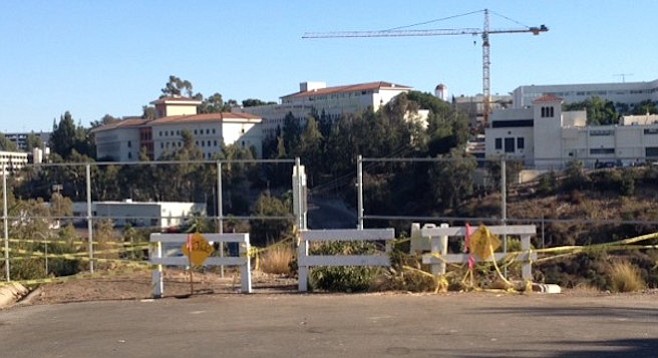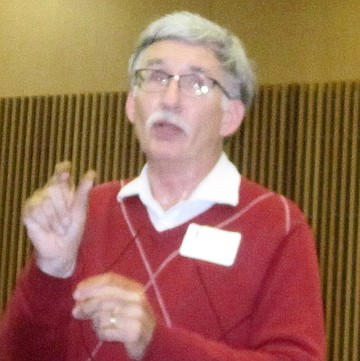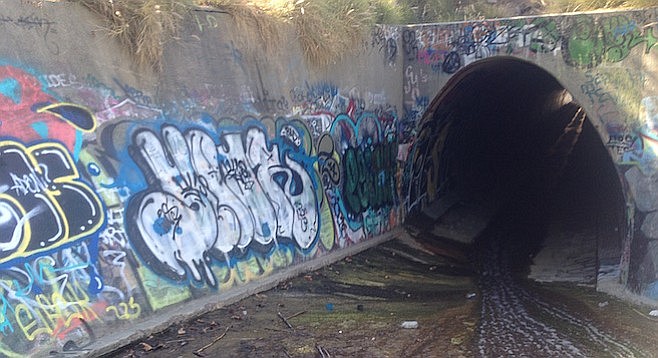 Facebook
Facebook
 X
X
 Instagram
Instagram
 TikTok
TikTok
 Youtube
Youtube

Adobe Falls is a class project for the 64 San Diego State University graduate students in professor Eric Frost’s Homeland Security 602 class.
Students are working on solutions to issues that include trespassing on land south of Del Cerro and north of westbound Interstate 8. A storm drain beneath I-8 connects the campus to the canyon where the university owns 32 acres, land closed to the public. The City of San Diego owns approximately 4 acres designated as open space, and people enter Adobe Falls on open land near homes on Mill Peak Road and Smoke Tree condominiums on Adobe Falls Road. Caltrans owns land that includes the main falls, and the lower falls are on university land, according to information that Frost provided during interviews conducted through November 11.

Frost is a Del Cerro resident and director of the Homeland Security program and the university’s Viz (Visualization) Center. Frost isn’t involved in university decision-making about the property that’s become a travel destination. The land with graffiti-covered rocks and boulders is on websites that include tripadvisor.com.
Frost said he recently saw an RV with Washington state license plates on Mill Peak. Another time, he spotted a group of about a dozen falls visitors waiting for their Uber ride. “Two women were drunk as skunks. When I went back about a half hour later, [I saw] they had left a large rum bottle.”

When interviewed, Frost elaborated on his presentation about the class at the October 27 Del Cerro Action Council meeting. “Adobe Falls is an example of how you solve” a problem that involves technology and people. The solution is often more complicated than a fence. “The real problem is how to disconnect visitors from the neighborhood” and going to Adobe Falls.
He said students couldn’t solve the problem without knowing who the visitors were, a learning process that included observing hundreds of people and “talking to more than 100 folks.” Most visitors learned about the falls from social media and the internet. They “figured out” where to find entrances on Google Maps and phone apps. Visitors’ Instagram posts about Adobe Falls totaled 6684 on November 8.
“Nearly all visitors are young, [in their] late teens and early 20s.” Some women go there for “photo shoots for modeling portfolios. It’s a false statement that visitors are SDSU students going to party.” Observation of more than 100 cars parked in the neighborhood showed a “very small number have [college and university] parking permits. The single biggest number” consisted of Palomar Community College stickers spotted last August. “The college has a major program for international students.” They received a list of places to visit that included Adobe Falls.
Approximately every other week, Frost’s students pick up litter. Discards like a Starbucks cup with a patron’s name provide “insight to who is there. Someone who can get Starbucks coffee is not homeless.” He added, “I learned more about blunts and medical marijuana. The most popular [flavor] is lemon....
“One positive aspect of young and vigorous people entering the canyon" is that they “disconnect the homeless methamphetamine users” from Adobe Falls. The methamphetamine “community” doesn’t want to be around them and “migrate to the east side of College Avenue.”
Frost said another issue is residents’ fear after the reported murder of one woman and rape of another one during a June 12 home invasion on Mill Peak Road. (According to news reports, police arrested Eduardo José Torres, and he pleaded not guilty on June 14 to felony charges that included murder, assault, and torture.)
One method of “disconnecting visitors, at least in the short term, is closing the back doors” (access north of I-8) and diverting people to the “front door,” the university entrance to the tunnel. Frost said the university installed a fence on Mill Peak Road. “No Trespassing” signs no longer include the words “Adobe Falls," information that would confirm to visitors that they “were at the right place.”
Frost told the Del Cerro council that students suggested keeping young people away by emitting high-pitched noises, playing classical music, or electrifying the fence. A woman in the audience liked the last idea. Frost said, “That won’t happen.”
He said in the interview that students’ “major final report” is due in December. The assignment includes proposing suggestions based on financial constraints, action “mimicking” the funding realities of homeland security agencies in other countries.
The class also discussed university research uses for Adobe Falls. Frost said the presence of an eight-foot-tall thistle was an indication of the rich soil that could be used for a farming project by the International Security and Conflict Resolution Program. That “fits with what the school is doing, trying to bring people in conflict together.” He cited the example of Jericho, where Israelis and Palestinians grow dates.
As for Adobe Falls, Frost said some students want to try to find solutions and “will continue to work on the problem” after the semester ends.


Adobe Falls is a class project for the 64 San Diego State University graduate students in professor Eric Frost’s Homeland Security 602 class.
Students are working on solutions to issues that include trespassing on land south of Del Cerro and north of westbound Interstate 8. A storm drain beneath I-8 connects the campus to the canyon where the university owns 32 acres, land closed to the public. The City of San Diego owns approximately 4 acres designated as open space, and people enter Adobe Falls on open land near homes on Mill Peak Road and Smoke Tree condominiums on Adobe Falls Road. Caltrans owns land that includes the main falls, and the lower falls are on university land, according to information that Frost provided during interviews conducted through November 11.

Frost is a Del Cerro resident and director of the Homeland Security program and the university’s Viz (Visualization) Center. Frost isn’t involved in university decision-making about the property that’s become a travel destination. The land with graffiti-covered rocks and boulders is on websites that include tripadvisor.com.
Frost said he recently saw an RV with Washington state license plates on Mill Peak. Another time, he spotted a group of about a dozen falls visitors waiting for their Uber ride. “Two women were drunk as skunks. When I went back about a half hour later, [I saw] they had left a large rum bottle.”

When interviewed, Frost elaborated on his presentation about the class at the October 27 Del Cerro Action Council meeting. “Adobe Falls is an example of how you solve” a problem that involves technology and people. The solution is often more complicated than a fence. “The real problem is how to disconnect visitors from the neighborhood” and going to Adobe Falls.
He said students couldn’t solve the problem without knowing who the visitors were, a learning process that included observing hundreds of people and “talking to more than 100 folks.” Most visitors learned about the falls from social media and the internet. They “figured out” where to find entrances on Google Maps and phone apps. Visitors’ Instagram posts about Adobe Falls totaled 6684 on November 8.
“Nearly all visitors are young, [in their] late teens and early 20s.” Some women go there for “photo shoots for modeling portfolios. It’s a false statement that visitors are SDSU students going to party.” Observation of more than 100 cars parked in the neighborhood showed a “very small number have [college and university] parking permits. The single biggest number” consisted of Palomar Community College stickers spotted last August. “The college has a major program for international students.” They received a list of places to visit that included Adobe Falls.
Approximately every other week, Frost’s students pick up litter. Discards like a Starbucks cup with a patron’s name provide “insight to who is there. Someone who can get Starbucks coffee is not homeless.” He added, “I learned more about blunts and medical marijuana. The most popular [flavor] is lemon....
“One positive aspect of young and vigorous people entering the canyon" is that they “disconnect the homeless methamphetamine users” from Adobe Falls. The methamphetamine “community” doesn’t want to be around them and “migrate to the east side of College Avenue.”
Frost said another issue is residents’ fear after the reported murder of one woman and rape of another one during a June 12 home invasion on Mill Peak Road. (According to news reports, police arrested Eduardo José Torres, and he pleaded not guilty on June 14 to felony charges that included murder, assault, and torture.)
One method of “disconnecting visitors, at least in the short term, is closing the back doors” (access north of I-8) and diverting people to the “front door,” the university entrance to the tunnel. Frost said the university installed a fence on Mill Peak Road. “No Trespassing” signs no longer include the words “Adobe Falls," information that would confirm to visitors that they “were at the right place.”
Frost told the Del Cerro council that students suggested keeping young people away by emitting high-pitched noises, playing classical music, or electrifying the fence. A woman in the audience liked the last idea. Frost said, “That won’t happen.”
He said in the interview that students’ “major final report” is due in December. The assignment includes proposing suggestions based on financial constraints, action “mimicking” the funding realities of homeland security agencies in other countries.
The class also discussed university research uses for Adobe Falls. Frost said the presence of an eight-foot-tall thistle was an indication of the rich soil that could be used for a farming project by the International Security and Conflict Resolution Program. That “fits with what the school is doing, trying to bring people in conflict together.” He cited the example of Jericho, where Israelis and Palestinians grow dates.
As for Adobe Falls, Frost said some students want to try to find solutions and “will continue to work on the problem” after the semester ends.
Comments